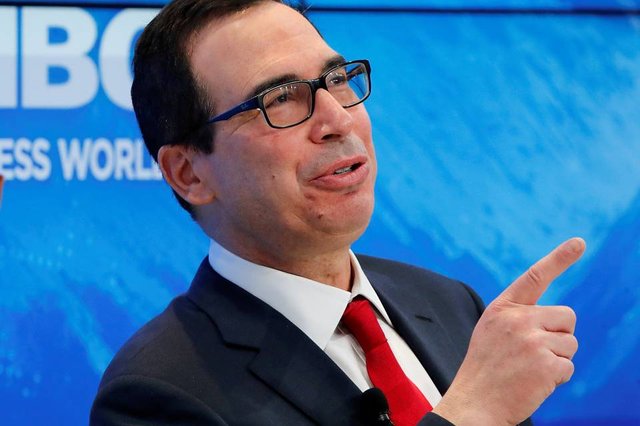
Treasury Secretary Steven Mnuchin’s recent dollar-moving remarks hearkened back to yesteryear, when secretaries were closely followed for their commentary about the dollar.
Global currency markets were briefly rattled last week when Mr. Mnuchin said that a weak dollar could be good for U.S. trade. His remarks were followed by President Donald Trump saying that “ultimately” he wants to see a strong dollar. On Friday, Mr. Mnuchin completed the three-act dollar drama by saying his initial remarks were “completely taken out of context.”
‘A strong dollar is good for the United States’
Jack Lew. Treasury secretary from 2013-17. The biggest news that Jack Lew ever made about the dollar was when he unveiled a plan to remove Alexander Hamilton from the $10 note, only to have a hit Broadway musical, among other things, force him to backtrack and instead propose putting Harriet Tubman on the $20. The second-biggest news he made about the dollar was when his signature (which would appear on the dollar bill) was revealed to be a goofy series of loops, and so Mr. Lew changed his signature. When it came to comments about the strength of the dollar, he stuck to the line that “I have been consistent in saying, as my predecessors have said, that a strong dollar is good for the United States.”
‘It’s very important…that we maintain a strong dollar’
Timothy Geithner. Treasury secretary from 2009-2013. Mr. Geithner stuck to the strong-dollar line too, even when the U.S. announced a goal of doubling its exports. “I believe deeply that it’s very important for the U.S. and the economic health of the U.S. that we maintain a strong dollar,” Mr. Geithner said.
‘When the dollar is at a lower level it helps exports, and I think exports are getting stronger as a result’
President George W. Bush’s Treasury secretaries—Paul O’Neill (2001-02) , John Snow (2003-06) and Henry Paulson (2006-09)—rhetorically supported a strong dollar, but their remarks carried little weight with markets, which pushed the dollar down almost continuously from 2002 to 2008. The dollar had been declining for over a year when Treasury Secretary John Snow made this statement of fact, in May of 2003, that “when the dollar is at a lower level it helps exports, and I think exports are getting stronger as a result.” Despite having voiced his support for a strong dollar in the past, these remarks were interpreted by some as an indication that—secretly and truly—the Bush administration favored a weak dollar. The White House was forced to issue a statement saying the dollar policy was unchanged and the U.S. favored a strong dollar. Later that May, Mr. Snow had said a “strong” dollar refers not just to its exchange rate value, but to other aspects of the dollar such as the confidence it inspires in the public and its resistance to counterfeiting.
President George W. Bush himself said the dollar’s slide had gone too far in mid-2003. That led to a several-month rally before the decline returned. It was not until mid-2008—when Fed Chairman Ben S. Bernanke joined Mr. Paulson in talking up the dollar, that the decline was really stemmed. Later in 2008, the dollar strengthened dramatically as investors sought the safety of U.S. assets during the global financial crisis. From its peak in 2002 to its trough in mid-2008, the broad trade weighted U.S. dollar declined nearly 27%.
‘We have had a strong dollar for some time now’
The heyday of caring about the Treasury secretary’s remarks on the dollar occurred in the late 1990s, under Treasury secretaries Robert Rubin (1995-99) and Lawrence Summers (1999-2001). In the 1990s, as the dollar was strengthening, Mr. Rubin and Mr. Summers stuck to a very careful script that “a strong dollar is in the interest of the United States.” In early 1997, Mr. Rubin slightly changed this script, saying that “we have had a strong dollar for some time now.” His remarks were taken as a subtle signal that the U.S. thought the dollar had gone too far. Still, the dollar strengthened an additional 10% over the rest of that year, after Mr. Rubin’s remarks.
The challenge for Treasury secretaries is that, ultimately, their words only carry lasting weight if they’re willing and able to back the rhetoric up by pulling policy levers—such as intervening in currency markets—but those levers have been little used for decades now.
The U.S. has participated in just three major currency interventions in the past two decades. In 1998, the U.S. moved to weaken the yen and prevent Japan’s economy from teetering into recession. In 2000, the U.S. joined other central banks in intervening to prop up the euro when it was a new currency. In 2011, the U.S. and other central banks helped weaken the yen, after Japan’s economy was in deep peril from that year’s tsunami which triggered a nuclear disaster at the Fukushima Daiichi power plant.
So, if you’re looking for big sustained moves in the dollar, pay attention to the Fed. Pay attention to whether U.S. growth is outperforming the rest of the world. Pay attention to oil production. Pay attention to whether investors crave safe havens. But unless you’re day-trading currencies, the lesson from the last two decades of Treasury secretary commentary on the strength of the dollar is probably this: Don’t worry too much about it.
Hi! I am a robot. I just upvoted you! I found similar content that readers might be interested in:
https://www.msn.com/en-us/finance/markets/a-brief-history-of-treasury-secretaries-trying-to-jawbone-the-dollar/ar-BBIsmmT
Downvoting a post can decrease pending rewards and make it less visible. Common reasons:
Submit